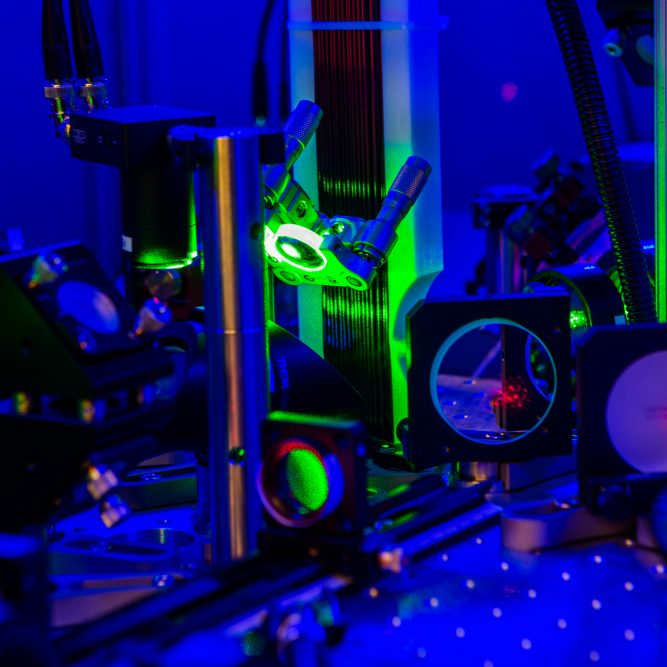In this thrust area we work towards the realization of new states of matter and the engineering of idealized model systems for many-body physics. Systems under study include strongly interacting Fermi gases and fermionic superfluids in one, two and three dimensions, spin systems, bosons and fermions trapped in optical lattices realizing the Bose- and Fermi-Hubbard model and beyond, as well as strongly interacting dipolar gases of ground-state molecules.
An important focus is the study of non-equilibrium dynamics of quantum systems. This includes the preparation
of quantum systems far away from equilibrium, and the study of relaxation behavior after quenches to a new Hamiltonian.
We also constantly strive to develop novel methods to probe and detect new quantum phases. Examples include:
quantum gas microscopes that allows for imaging of atoms in optical lattices with single-site resolution, or spin-injection spectroscopy that enables the direct observation of spinful bands in spin-orbit coupled Fermi gases.
Dressing quantum gases by electromagnetic fields allows for the realization of spin-orbit coupled Fermi gases as well as the study of quantum gases in large effective magnetic fields.
Polarons
CUA experimentalists pioneered the study of Fermi polarons using RF spectroscopy to measure the polaron energy and quasiparticle residues. This problem was further developed by CUA theorists who analyzed the case of heavy impurities and calculated the entire spectral function and analyzed dynamics probed in Ramsey type interferometric experiments. Their theoretical model describing the “birth” of the Fermi polaron has been confirmed by recent experiments in Innsbruck. However quantitative understanding of the effects of finite mass of impurities remains an open theoretical challenge. Finite mass has a non-perturbative effect of changing the zero temperature spectrum from power law singularity arising from orthogonality catastrophe to a delta-function peak characteristic of a finite quasiparticle residue. In the case of Bose polarons manifestations of strong interactions are even more dramatic. When impurity is suddenly introduced into a Bose gas it can bind not one but many host atoms since the latter are not subject to the Pauli exclusion priniciple. Thus understanding dynamics of Bose polarons near unitarity requires detailed analysis of the interplay of few- and many-body physics.
Polaronic physics plays a crucial role in the Fermi Hubbard model that is being explored in quantum microscopes. When holes are introduced into an antiferrmagnetic Mott insulator their motion is strongly coupled to spin wave excitations. Earlier studies of the zero temperature dynamics of such magnetic polarons demonstrated such striking features as dramatic renormalization of the quasiparticle dispersion and residue. Dynamics of magnetic polarons at finite temperatures, especially close to the magnetic ordering transition, as relevant to current experiments with ultracold atoms has not been studied at all. One of the important questions is the character of magnetic correlations around a hole in real space. Such correlations could not be accessed in traditional sold state systems but can be probed directly in experiments with quantum microscopes that have single site resolution. Another important question that we plan to address is interactions between holes induced by spin waves and formation of bi-polarons as a precursor of pairing.
Transport
Understanding dynamical and transport properties of strongly interacting many-body systems is one of the most fundamental challenges of modern physics. Some of the longest standing problems in condensed matter physics include transport properties of electron systems in the strongly interacting regimes. In spite of many years of active experimental and theoretical research we are still far from understanding the origin of the linear in temperature resistivity in high temperature superconductors; the famous 0.7 anomaly in the resistivity in one dimensional electron gases remains a major puzzle in mesoscopic physics; the nature of transport at the superconductor to insulator transition in thin films and wires remains a subject of active debate. In other areas of physics transport of strongly interacting systems is also at the frontier of current research. Important open problems include kinetic theory of quark-gluon plasma, charge and energy transport in biological macromolecules.
Ultracold Bose and Fermi atoms are a promising new platform for studying transport in systems with highly tunable microscopic parameters including dimensionality, band structure, coupling to the environment, and interactions between particles. In addition to providing new insights on the transport phenomena that have already been observed in other systems, ultracold atoms can realize new regimes and new types of transport experiments that have no analogues in traditional condensed matter physics. Analysis of a broader class of transport phenomena will make it possible to achieve a deeper understanding of the general problem of non-equilibrium dynamics of many-body quantum systems. Comparison of experiemntal results with theoretical analysis will play a crucial role in this challenging quest by providing benchmarks for theoretical models.
We plan to study transport in spatially confined traps that can be realized in quantum microscopes. Our goal is to understand the change of transport as interactions in the system are changed from the Fermi liquid to to strongly interacting systems.
